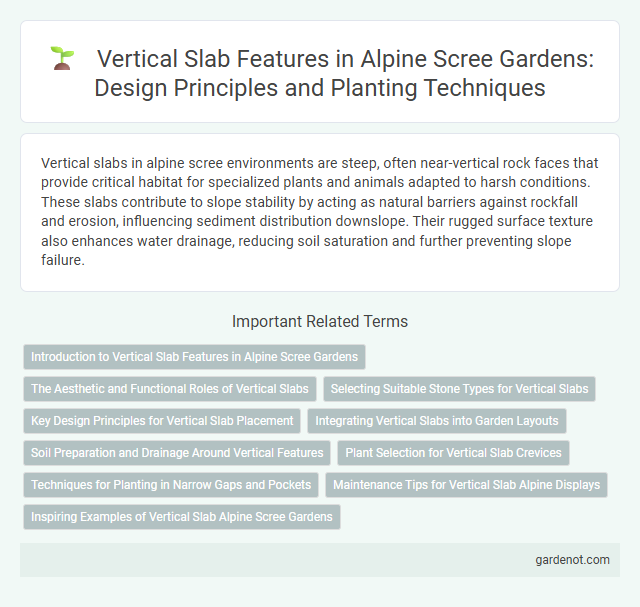Vertical slabs in alpine scree environments are steep, often near-vertical rock faces that provide critical habitat for specialized plants and animals adapted to harsh conditions. These slabs contribute to slope stability by acting as natural barriers against rockfall and erosion, influencing sediment distribution downslope. Their rugged surface texture also enhances water drainage, reducing soil saturation and further preventing slope failure.
Introduction to Vertical Slab Features in Alpine Scree Gardens
Vertical slabs in alpine scree gardens present striking geological formations characterized by steep, often sheer rock faces that enhance the texture and visual complexity of the landscape. These slabs provide essential habitats for specialized alpine plants, supporting biodiversity by offering niches with varied moisture and sunlight exposure. Understanding vertical slab features aids in designing resilient scree gardens that mimic natural alpine conditions and support sustainable plant growth.
The Aesthetic and Functional Roles of Vertical Slabs
Vertical slabs in alpine scree landscapes serve both aesthetic and functional roles by creating striking visual contrasts against loose rock debris. These sheer rock faces stabilize the slope by reducing erosion and providing anchor points for vegetation, which further strengthens the scree's structure. Their pronounced verticality also influences local microclimates, affecting moisture retention and temperature variations critical for alpine flora and fauna.
Selecting Suitable Stone Types for Vertical Slabs
Selecting suitable stone types for vertical slabs in alpine scree environments requires prioritizing durability and resistance to freeze-thaw cycles. Granite and basalt are preferred due to their dense, non-porous structure, minimizing water infiltration and subsequent fracturing. Choosing stones with high compressive strength and low porosity ensures long-lasting stability and reduced maintenance in harsh mountain conditions.
Key Design Principles for Vertical Slab Placement
Vertical slab placement in alpine scree requires precise evaluation of rock stability and fracture patterns to ensure secure anchoring. Emphasizing proper orientation along natural fault lines and minimizing exposure to weather-induced erosion enhances long-term durability. Optimal design incorporates load distribution analysis and material compatibility to prevent slab displacement during freeze-thaw cycles.
Integrating Vertical Slabs into Garden Layouts
Vertical slabs create striking focal points in Alpine scree gardens by adding height and texture that mimic natural cliff faces. Incorporating these slabs improves drainage and supports alpine plants like saxifrage and edelweiss, which thrive in well-drained, rocky substrates. Strategic placement near pathways or water features enhances visual interest while maintaining the scree garden's rugged, mountainous character.
Soil Preparation and Drainage Around Vertical Features
Vertical slabs in alpine scree environments require meticulous soil preparation to ensure stability and support for vegetation growth. Proper drainage systems must be installed to prevent water accumulation around these vertical features, reducing erosion and promoting root health. Implementing gravel layers and French drains enhances water runoff management, maintaining structural integrity and soil aeration.
Plant Selection for Vertical Slab Crevices
Plant selection for vertical slab crevices in alpine scree prioritizes species with strong root anchorage and drought tolerance, such as Saxifraga oppositifolia and Androsace alpina. These plants exhibit adaptations like compact growth and fleshy leaves to withstand extreme temperature fluctuations and limited soil moisture. Choosing native alpine species enhances ecological stability and promotes biodiversity in these harsh, vertical microhabitats.
Techniques for Planting in Narrow Gaps and Pockets
Planting in narrow gaps and pockets on vertical slabs in alpine scree requires specialized techniques such as utilizing fibrous-rooted species that anchor securely in minimal soil. Employing mosses and lichens as ground cover helps retain moisture and stabilize substrates in these challenging microhabitats. Strategic placement of soil pockets combined with micro-irrigation techniques enhances plant establishment and survival on steep, rocky vertical surfaces.
Maintenance Tips for Vertical Slab Alpine Displays
Regular inspection of vertical slab alpine displays prevents stone displacement and erosion by identifying loose debris and cracks early. Applying water-resistant sealants enhances durability against harsh mountain weather, while prompt removal of moss and lichen preserves the rock surface's integrity. Ensuring proper drainage around the slab reduces water accumulation, minimizing freeze-thaw damage in alpine conditions.
Inspiring Examples of Vertical Slab Alpine Scree Gardens
Vertical slab alpine scree gardens showcase unique landscaping that mimics natural rocky mountain environments with steep, exposed rock faces. These gardens emphasize the use of large, vertically positioned stone slabs that provide excellent drainage and microhabitats for specialized alpine plants such as saxifrage and sedum species. Inspired examples include the Alpine Garden of the Royal Botanic Gardens Kew and the Rock Garden at the University of British Columbia, both demonstrating creative integration of vertical stone elements with resilient alpine flora.
Vertical slab Infographic

 gardenot.com
gardenot.com